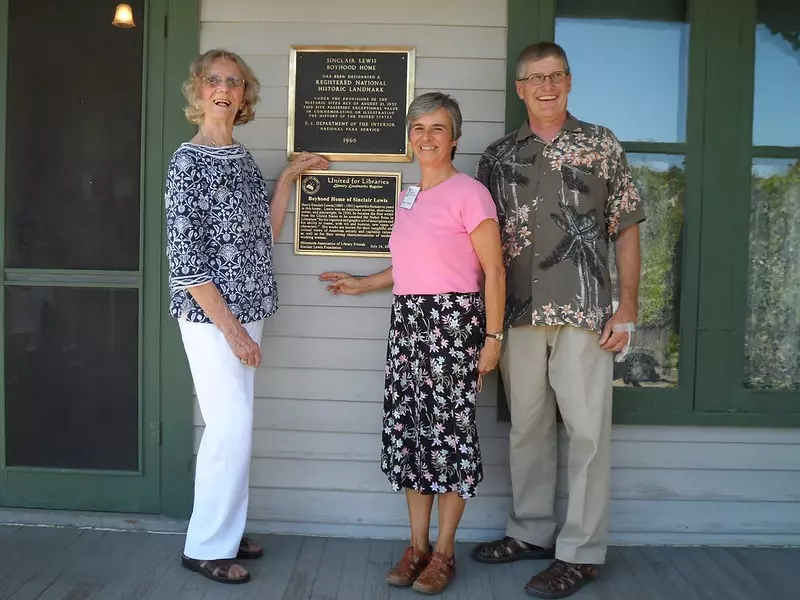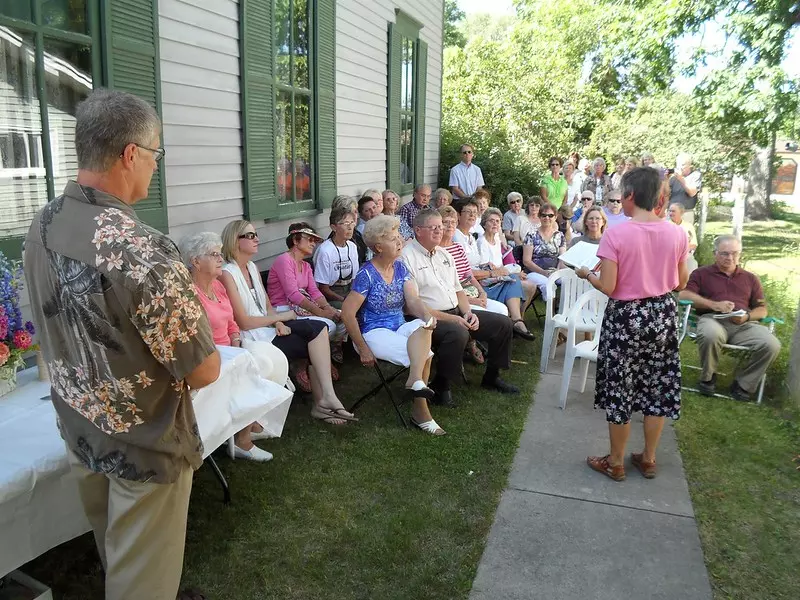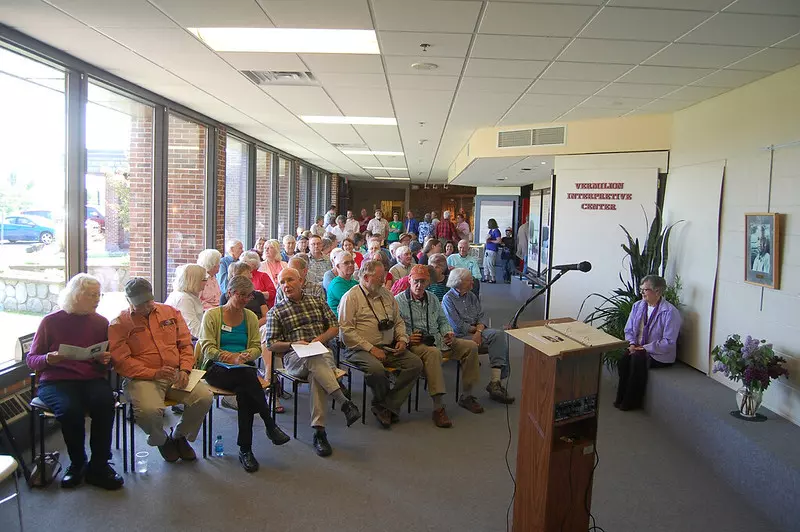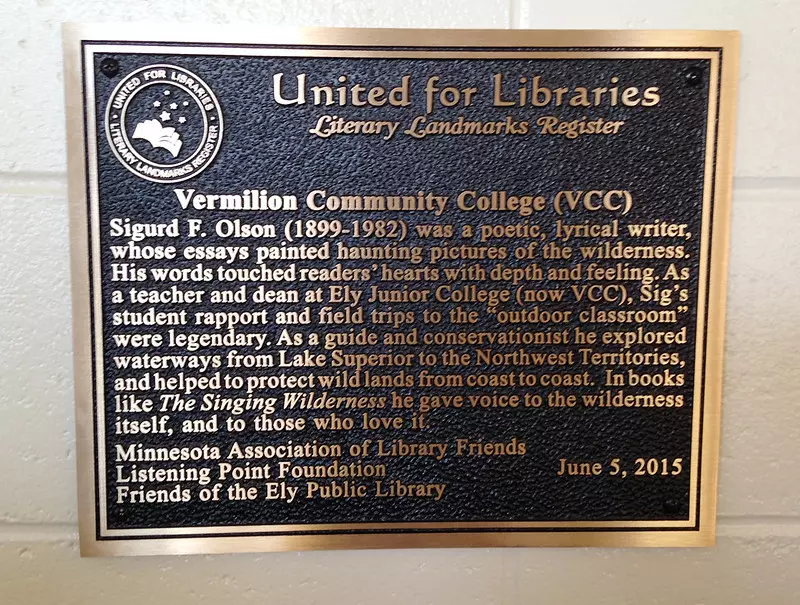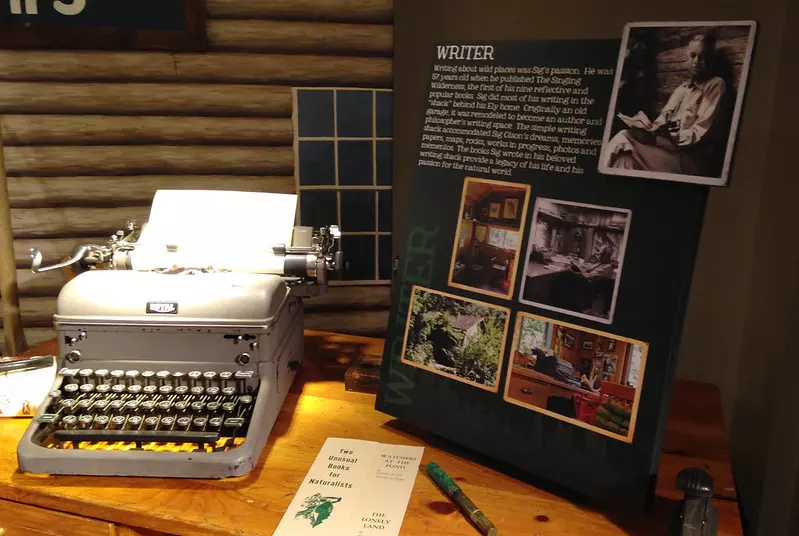United for Libraries Literary Landmarks™
Literary Landmarks is a trademarked and long-running program of United for Libraries, the Friends' arm of the American Library Association. As the name suggests, the intent is to celebrate the rich literary tradition in every corner of our country by acknowledging locations that were important to America’s greatest writers. Examples run the gamut: from the homes of Tennessee Williams, Stephen Crane, and Dashiell Hammet; libraries associated with Robert Frost and Herman Melville; and even bars frequented by Jack London, F. Scott Fitzgerald, and Ernest Hemingway.
Literary Landmarks are made possible through partnerships between United for Libraries and local Friends of the Library (or like-minded organizations). With seven different sites, Minnesota boasts more Landmarks per capita than nearly any other state! MALF has been proud to spearhead the coalitions behind the four most recent dedications (2013-2017).
Note: Literary Landmarks is currently on a national hiatus pending administrative changes. No new applications will be accepted in the interim.
MALF's Literary Landmarks:
Who is Richard Eberhart?
Mower County’s famous native son is a worthy addition to these esteemed ranks. Born in Austin in 1904, Eberhart spent his formative years at the family’s 40-acre estate just outside of town. While he enjoyed a privileged and happy childhood, financial setbacks and the unexpected death of his mother marred his later adolescence.
 As fans of Eberhart’s work are quick to point out, much of his Pulitzer Prize- and National Book Award-winning poetry is inspired by both the highlights and travails of this childhood in Austin. Particularly evident are his lifelong fascination with nature, exploration of fate, and fixation with the mysteries of death. Given this focus, contemporary and modern critics alike compare Eberhart – usually quite favorably – to William Wordsworth and the other nineteenth-century English masters of Romanticism.
As fans of Eberhart’s work are quick to point out, much of his Pulitzer Prize- and National Book Award-winning poetry is inspired by both the highlights and travails of this childhood in Austin. Particularly evident are his lifelong fascination with nature, exploration of fate, and fixation with the mysteries of death. Given this focus, contemporary and modern critics alike compare Eberhart – usually quite favorably – to William Wordsworth and the other nineteenth-century English masters of Romanticism.
Eberhart’s journey to worldwide acclaim took him from Minnesota first to Dartmouth College (his future academic home) and later to Cambridge. After completing his coursework, Eberhart visited exotic locales (including most notably Siam, where he spent 1930 as personal tutor to the son of King Prajadhipok). Once back statewide, he quickly made a name for himself as a thoughtful teacher of English and poetry – and an up-and-coming poet in his own right.
After an interlude during which Eberhart served as a lieutenant in the U.S. Navy, Dartmouth appointment him poet-in-residence. He would remain with the institution, in some capacity, until his death in 2005 at the ripe old age of 101. At various times, Eberhart also doubled as poet laureate for the state of New Hampshire, official poet consultant for the Library of Congress, and a member of important federal advisory committees dedicated to the arts.
Over this long and fruitful academic career, Eberhart found time to publish a dozen books of poetry. Standouts include Burr Oak (1947), named after his childhood estate in Austin; Selected Poems, 1930-1965, winner of the 1966 Pulitzer Prize for Poetry; and Collected Poems, 1930-1976, winner of the National Book Award.
Poems held in particularly high regard today include “The Groundhog,” a rumination on mortality and the uniqueness of human consciousness, and "The Fury of Aerial Bombardment," an ode to wartime loss inspired by his own WWII experiences.
Who is Sigurd Olson?
The Midwest boasts more than its fair share of environmentalist luminaries and famous nature writers. While household names like Aldo Leopold, Gaylord Nelson, and John Muir rank near the top of that list, none has left a more indelible mark on Minnesota than native son Sigurd Olson.
 Olson is best remembered today for championing wilderness conservation through nine bestselling books, beginning with The Singing Wilderness in 1956 and his seminal Listening Point in 1958. The latter is named for Olson’s personal retreat, located on scenic Burntside Lake just outside of Ely, Minnesota. Olson and wife Elizabeth lived in the Ely area most of their adult lives.
Olson is best remembered today for championing wilderness conservation through nine bestselling books, beginning with The Singing Wilderness in 1956 and his seminal Listening Point in 1958. The latter is named for Olson’s personal retreat, located on scenic Burntside Lake just outside of Ely, Minnesota. Olson and wife Elizabeth lived in the Ely area most of their adult lives.
Sigurd Olson’s corpus of work struck a chord with the American public thanks to his approachable, unpretentious writing style, coupled with an ability to speak from a position of authority. Olson held advanced degrees in geology, botany, and agriculture, and taught for many years at Ely Community College (now Vermilion Community College). He rounded out his academic career with stints as science department chair and dean of that Ely institution, before retiring from academia to write full time in 1947.
In truth, retirement proved something of a misnomer, as Olson took the opportunity to redouble his conservation efforts. He served as vice-president and then president of the National Parks Association (1951-1959), as vice-president and then president of the Wilderness Society (1963-1971), and as a special advisor to both the Secretary of the Interior and the National Park Service (1959-1971). His efforts played a direct role in the establishment of national preserves ranging from the Arctic Wildlife Refuge in Alaska to Point Reyes National Seashore in California.
Closer to home, Olson’s advocacy also proved instrumental to the legislation that created Voyageurs National Park and the Boundary Waters Canoe Area Wilderness in northern Minnesota.
Olson’s tireless efforts garnered him national praise and honors in his lifetime, including the highest award bestowed by four of the five leading conservation organizations in the U.S. He died in 1982, but his legacy lives on at Listening Point – now on the National Register of Historic Places and managed by a wilderness education foundation of the same name.
Writers like Sinclair Lewis and, more recently, Garrison Keillor, have gained national renown for their portrayals of life in small-town Minnesota. However, no author’s depictions have resonated quite as strongly with native Minnesotans as those of the inimitable Jon Hassler.
Jon Hassler, a teacher by training, burst onto the writing scene in a big way in 1977 with the publication of his first novel, the perennial bestseller Staggerford. The debut garnered Hassler accolades from all corners – for a strong narrative voice, engaging plot devices, and, above all, a refreshingly authentic look at town dynamics in a small Midwestern town.
Over the next three decades, Hassler contributed another dozen novels to the corpus of Minnesota literature, in addition to several well-received nonfiction works, short stories anthologies, and children’s books.
While this high level of productivity is an achievement in its own right, it is all the more impressive for the fact that Hassler never gave up his “day job.” Far from leaving academia, he moved through the ranks – from a high school teacher, to a college professor at Bemidji State University and Brainerd’s Central Lakes College, to Writer in Residence and Regent’s Professor at St. John's University in Collegeville, Minn.
Hassler’s real-life experiences infused his fiction writing, with teachers (like Staggerford’s Agatha McGee) accounting for several of his most beloved characters.
Hassler passed away in 2008, at age 74, after a long and courageous battle with a Parkinson’s-like disease.
While his pluck and candor gained him famous fans in life, including Hillary Clinton and Angela Lansbury, no one mourned Hassler more in death than the small Minnesota communities that figure so prominently in his fiction. In September 2008, in recognition of this fact, Central Lakes College renamed its library the "Jon Hassler Library" in his honor.
 What do F. Scott Fitzgerald’s St. Paul birthplace and Willa Cather’s beloved Nebraska prairie home have in common with a corner tavern in New York, a cemetery in Virginia, and a courthouse in Michigan?* All are Literary Landmarks, sites with a strong historical connection to prominent American authors and recognized through a joint partnership between United for Libraries’ Literary Landmarks Association and local affiliates.
What do F. Scott Fitzgerald’s St. Paul birthplace and Willa Cather’s beloved Nebraska prairie home have in common with a corner tavern in New York, a cemetery in Virginia, and a courthouse in Michigan?* All are Literary Landmarks, sites with a strong historical connection to prominent American authors and recognized through a joint partnership between United for Libraries’ Literary Landmarks Association and local affiliates.
In the summer of 2013, the Minnesota Association of Library Friends (MALF), together with the Sinclair Lewis Foundation, added the Sinclair Lewis Boyhood Home in Sauk Centre, Minn., to the esteemed and growing list of Literary Landmarks.
Harry Sinclair Lewis is perhaps best known for penning the great American novels Main Street, Babbitt, Arrowsmith, and Dodsworth, and for being the first writer from the United States to be awarded the Nobel Prize in Literature (1930).
